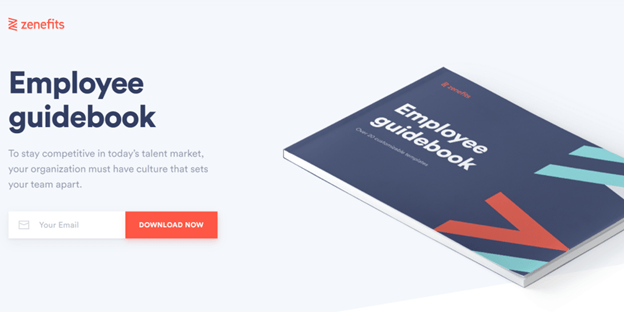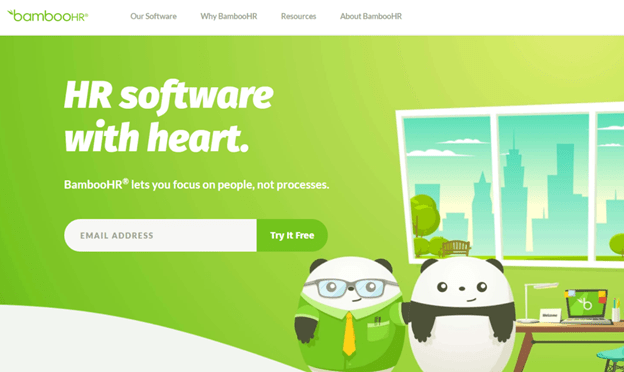The last thing you want when you give a new hire your employee handbook is for them to bury it in their desk without cracking it open. But if you want your employees to read and reference it later, you have to make them want to pick it up.
The employee handbook is an integral part of the onboarding process. Here’s how you can create one that people want to read.
What is an Employee Handbook?
An employee handbook is a document that lays out your company policies, procedures, and employee expectations. It gives comprehensive information about your company and should outline everything that someone working there needs to know.
That doesn’t include job-specific information. Instead, it talks about the company’s values, goals, and vision, and often has welcome letters from the CEO or president of the company. The handbook varies between companies, so yours will look different from another business, even within your industry.
The Basics of Employee Handbooks
All employee handbooks should follow a similar structure. However, it varies based on the size of the company, the type of company, and what your employees need to know. Here’s what you should include in your handbook, no matter your business.
Company History and Mission
It may not be the most important part of the handbook, but talking about the company’s history and mission helps new employees get to know your business. It doesn’t have to be long, but include things like:
- You overall mission statement
- Company founder information
- How the company got started
- Executive leadership team information
This section sets the tone of the handbook and gives new employees their first impression of your company culture.
You can talk about the “why” of the company—who you serve, your customer base, your marketplace position, and some of the more emotional and meaningful aspects of that company. It gives the reader a warm welcome before you get into the technical parts of their employment.
Time Off Policies
Your employees want to maintain a healthy work-life balance. Paid time off (PTO) is one of the most critical factors that let them do that (or don’t).

This section should include things like:
- How your employees earn PTO
- How to request or schedule PTO
- Vacation policies
- Sick leave policies
- Family medical leave
- Any other leave your company offers
Here, you should talk about which holidays your company closes for and if there are any it doesn’t close for. For example, many retail stores are open on major bank holidays while most corporate offices are closed. You should also include how your employees will be paid for working those holidays.
Employee Expectations
This section outlines how you expect your employees to behave in the workplace. That can mean your harassment policy, dress code, the use of company internet, and any policies you have about smoking, drinking, or using other substances that interfere with the person’s job performance.
Outline the break rules for your employees. If you allow them a 30-minute lunch break and two 15-minute breaks during the day, put that in this section along with clocking in and out procedures.

When it comes to employee conflicts—which will inevitably happen—you don’t need to get too detailed. It’s better if you don’t.
Keep those policies general and talk about what to do in the event of a conflict instead. That might mean speaking with the employee’s manager or reporting it to HR to help resolve the issue.
You can’t outline every possible topic, so focus on what employees should generally know if a conflict arises.
You can also mention any specific anti-harrassment or anti-discrimination policies here and let the employees know how they can expect to be treated—let them know you care about your employee’s health, safety, and well-being. While there is a later section in the handbook regarding all policies, these may be important ones to reiterate, along with how an employee can report any issues.
Payment and Promotion Policies
Do you pay your employees weekly? Every other week? Once a month? Whatever the case, make it clear when and how employees get paid in the handbook.
No one likes surprises when it comes to receiving their paycheck unless it comes in the form of a bonus. Talk about how many pay periods you have, whether employees can opt for direct deposit instead of paper checks, and other payment information. You should also include details about expected work hours.

Ensure your employees understand how overtime and pay grades and raises work. That way, they know where they are on the scale and what type of company growth is possible.
If you offer bonuses or rewards for performance, say so here. This is also the place to talk about specific advancement policies.
It is critical that if you have an advancement policy, you follow it. If you don’t, it can lead to low company morale and lower retention rates and cause other issues within your business.
Be upfront with your payment and promotion policies. No one wants to be promised one thing and receive another, especially when it comes to compensation.
Employee Benefits
You don’t need to discuss specific benefits policies, as those can change frequently.
But you should talk about eligibility for benefits. Do you only offer them for full-time employees? If you provide them for part-time employees, put those requirements in this section.

Discuss insurance benefits, including what kinds and options your company offers. You don’t need to talk about providers, but you should tell your employees whether you provide the following:
- Health insurance
- Dental
- Vision
- Life insurance
Make sure you also go over employee enrollment periods to ensure employees don’t miss them.
Include significant life events, like the birth of a child, death in the family, marriage, and worker’s compensation in case of an injury on the job.
Offering this information shows employees that you’ve thought of their needs and have resources available should they need them.
Policies Required by Law
Sometimes, you need to include additional information by law. That varies based on where you live.
Some US states have state-specific employment laws along with federal ones. You must pay attention to those to make sure you abide by both. Some of those policies are required to be in your employee handbook.
If you don’t know what policies you need to include, the HR department or an attorney can help ensure you have the correct information. You can also find more information on your labor department website.
Some of the policies you may need includes:
- Family medical leave
- Equal opportunity and non-discrimination
- Worker’s compensation
- Military leave
- Disability benefits
- Breastfeeding accommodations
Because this varies by state, not every law will apply to your business. However, knowing those that do ensures you don’t leave out crucial information.
Disclaimers
Disclaimers make it clear from the start how employees should use the handbook and what it is meant for.
Many employees know what the handbook is, while others have never read or received one before. Assume that the employee knows less and put the disclaimers at the beginning.
Make sure employees know it’s not a contract and doesn’t make any employment guarantees. Make it known the handbook is the ultimate source on overall workplace procedures and policies and how employees should follow them.
Let your employees know in the handbook that policies are subject to change. You should update your handbook as necessary whenever anything changes.
Every business owner will face unexpected challenges. Some of those issues are significant enough to warrant space in the employee handbook.
At the end of the handbook, include an employee acknowledgment page. Make it detachable with a statement saying that the employee acknowledges that they have received a copy of the handbook and understands that they are responsible for reading it and following the guidelines.
Have them sign that page and hand it into HR or the appropriate person, depending on how your business operates.
3 Tools to Improve Your Employee Handbook
The idea of writing an employee handbook can feel overwhelming, especially when you have a lot of information to include. Here are a few tools you can use to create and update your employee handbook.
Zenefits

Zenefits offers a free employee handbook template. Sometimes the hardest part is knowing where to start. Zenefits gives you the resources you need for a strong first step.
With its customizable template, you can put in any of the sections we talked about and more based on your business needs and policies.
Zenefits helps you develop each area of your handbook, including your mission statement and story. It makes it easy to talk about benefits and go deeper into what it means to be part of your team.
The software offers comprehensive HR features, too. It helps employees onboard and integrate into your workplace seamlessly.
Zenefits offers three packages:
· Essentials: $8 per month per employee
· Growth: $14 per month per employee
· Zen: $21 per month per employee
All packages offer Core HR, time and scheduling, integrations, and mobile app features.
As you upgrade, you get other features, like compensation and performance management, People Hub, and employee engagement surveys.
Zenefits also has add-ons to boost the capabilities of any plan, like payroll and advisory services.
BambooHR

BambooHR has an employee database, making it easy for new hires—and old ones—to access any documents they need to reference, including the handbook.
Beyond its paid packages, BambooHR offers a ton of free resources to help you figure out what you need to put in your handbook and check them off on their checklist, complete with infographics.
It ensures that once you create your handbook, you won’t have to worry about people having different versions. You can keep them all electronically updated in your system.
BambooHR doesn’t list its pricing on the company website because they tailor its packages to your company. You can contact their sales team for details and help building your package.
Gusto

Gusto has its own guide for helping you create an employee handbook on their site. They also have tons of other resources, from their blog to downloadable resources that help you create your handbook.
If you don’t want to or don’t have time to write your own, Gusto also has a service where you can request a handbook from them. They offer two options: Express Handbook and Professional Handbook.
For both options, you start by answering questions about your company. The Express Handbook option creates an employee handbook for you in about 30 minutes.
The Professional Handbook option lets you consult with a professional HR team to ensure your handbook has everything you want in it and covers all your company’s bases. Plus, it saves you time creating one yourself, and you get your handbook done in less than a week.
Gusto has three packages:
· Core: $39 per month + $6 per month per person
· Complete: $39 per month + $12 per month per person
· Concierge: $149 per month + $12 per month per person
Gusto offers a full HR service suite. Its upper tiers have more for HR and onboarding.
With Concierge, you have access to more professionals and resources to help you make your business the best it can be. However, Complete also has comprehensive hiring and onboarding options for a lower price.
3 Tricks for Creating Employee Handbooks
Although most employee handbooks stick to a similar format, there are ways to make yours work better for your company. Here are a few tricks you can use to make your employee handbook more unique and engaging.
Use Storytelling
Your employees are human, and people get more invested when you tell them a story they can connect with. Just like when you’re telling a story to a friend, you want your company to be a place your employees can relate to and feel good working for.
Beyond crafting a story about the company history, you can give specific examples highlighting possible scenarios employees may find themselves in. That way, you show them how to work through problems they encounter in the workplace and give them a better foundation than simply describing policies and procedures.
Keep It Conversational
Just because your employee handbook is an official document doesn’t mean it has to sound stiff and formal. You want it to keep your employees engaged, and conversational language makes policies easier to understand.
Your language here sets the tone for your company. If you want to come off as an approachable environment, make your handbook match that culture. And don’t forget to describe your company culture and explain how you and the leadership team work to make that culture a reality throughout the organization.
Use An Appealing Design
An employee handbook isn’t all about the words you use. It’s about how it looks, too.
People are more likely to read something with images—preferably from your actual company, not just stock photos—and some level of graphic design.
First, find a graphic designer. There are lots of companies and freelance designers out there to choose from. There may also be an internal employee with graphic design experience.
Communicate the image of your company to the designer. That might include a color scheme, layout, graphics, images, and infographic ideas.
Work with the designer throughout the process to ensure that the result fits the image of your company and is something you’re proud to give each employee.
The finished product should embody your company culture and give your employees a break from the walls of text found in contracts and other hiring documents.
What to Do Next
While employee handbooks give your team the basics of overall company conduct, you’ll need to go deeper. That’s why you need to know how to manage your team after you’ve hired all the right people.
Project management software helps you keep your team connected and on track for all projects. It lets you bring your carefully built team together so you can finish projects efficiently and keep innovating.
You also need to manage all your HR needs once you’ve hired people. HR software can track payroll, benefits, and time off while helping you with scheduling and time tracking. Plus, next time you need to hire someone, knowing that your software can help with recruiting and onboarding can save you time and hassle.
from Quick Sprout https://ift.tt/3wKbUl2
via IFTTT
